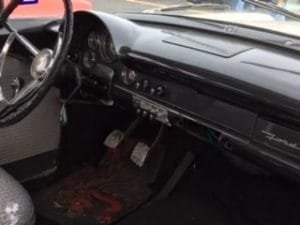Featured here is a nicely restored 1956 Ford Customline Tudor Sedan. The Customline trim model was introduced in 1952. The first generation Ford Customline was produced from 52 through the 54 model year and was positioned below the Crestline and above the Mainlinetrim models. The second generation Customline covered the 1955 through 1956 model years.

At it’s introduction, the Crestline trim level had ample chrome compared to the lower cost Customline trim.
1956 Ford Customline
The 1956 Ford Customline models were positioned below the Fairlane and again above the Mainline. The entry-level Ford Customline did not include a lot of chrome and trim compared to the top of the line Fairlane.
The 1956 Ford Customline bodies were similar to the 1955 models with some changes. The year earlier 1955 model did receive an entirely new redesign for the second generation.
Significant changes for 1956 vs. the previous year was a new grille and a wrap around parking light lens. The roof was lowered one inch but headroom remained the same. There was also new side trim added.

In the U.S., the Customline trim models stopped production after 1956. Ford Australia did continue to produce the Customline through the 1959 model year.
Ford put forth several trim lines for 1957 which included the base Custom, Custom 300, the Fairlane and the top trim level of the Fairlane 500.
1956 Ford Customline Specifications
The standard engine for the 1956 Customline was a 223 cubic inch six cylinder delivering 137 HP. Also available was a Ford Y-Block 272 cubic inch V-8 putting out 176 HP. The Y-Block Ford V-8 replaced the flathead and was Ford’s first OHV V-8 engine. The Y-Blocks were built from 1954-’64 and were uti;lized in Fords, Mercurys, Edsels and Ford trucks. The engine has deep skirting and makes the block resemble the letter Y.
Standard gearbox was a three speed manual. A three speed automatic was optional.
Brakes were four wheel hydraulic drums.
Power steering was offered as an option.
Car dimensions include a 115.5 inch wheelbase..198.5 inch overall length..75.9 inch width..62.1 inch height. Curb weight was about 3,575 lbs. Original base price was about $1,850.
Front suspension called “Angle-Poised Ball Joint Front Suspension“. This independent unit replaced the old kingpin design with ball joints, rubber-bushed transverse links and coil springs over hydraulic tube shocks. The rear suspension was a live axle, longitudinal semi-elliptic leaf springs and hydraulic tube shocks.
Total Ford Customline production for the 1956 model year was 368,600 vehicles. Ford passenger car production (excluding Thunderbird totals) for the 1956 model year was 1,392,847 vehicles.
See additional Auto Museum Online article found on the links below…
 Reference material for this article includes...Fifties Flashback: The American Car by Dennis Adler..February 1955 Motor Trends Magazine..Collectible Cars by the editors of Consumer Guide..1956 Ford Customline Owners Manual.
Reference material for this article includes...Fifties Flashback: The American Car by Dennis Adler..February 1955 Motor Trends Magazine..Collectible Cars by the editors of Consumer Guide..1956 Ford Customline Owners Manual.
1956 Ford Customline Collector Car Values
When you’re looking at mid 1950’s classic cars, Chevrolet appears to lead the pack. Current asking prices for excellently restored examples reflect this much. During this same time period Ford also introduced creative restyling and caught plenty of attention. In fact, 1955 was a record sales year for Ford. While the Customline models were a step below the Fairlanes, they offer plenty of value today for buyers/collectors looking for a piece of mid 50’s Americana.
 The 1956 Ford Customlines currently have a value in a large range. Asking prices range from aboutf $6,500 to $25,000 depending on overall condition, mileage, originality and of course degree of restoration, if any.
The 1956 Ford Customlines currently have a value in a large range. Asking prices range from aboutf $6,500 to $25,000 depending on overall condition, mileage, originality and of course degree of restoration, if any.
As classic cars from the 1950’s go, the Ford Customline is a relatively affordable vehicle to begin a collection with.
(Article and photos copyright Auto Museum Online)
